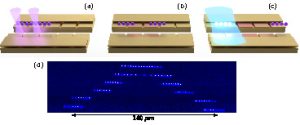

We have demonstrated two examples of quantum circuits that allow a verifier to certify a quantum computer, without the verifier having a quantum computer himself. The protocols rely on interactions between prover and verifier and are an extension of “interactive proofs” used in computer science. We demonstrate quantum circuits based on a particular cryptographic function as well as a “learning with errors” model, both passing the threshold for quantum behavior. Importantly, this requires measurement of a subset of qubits and subsequent coherent feedback on the remaining qubits, which we demonstrate in the trapped ion system of up to 15 qubits.
- “Experimental Implementation of an Efficient Test of Quantumness,” L. Lewis, D. Zhu, A. Gheorghiu, C. Noel, O. Katz, B. Harraz, Q. Wang, A. Risinger, L. Feng, D. Biswas, L. Egan, T. Vidick, M. Cetina, and C. Monroe, arXiv:2209.14316 (2022).
- “Interactive Protocols for Classically-Verifiable Quantum Advantage,” D. Zhu, G. D. Kahanamoku-Meyer, L. Lewis, C. Noel, O. Katz, B. Harraz, Q. Wang, A. Risinger, L. Feng, D. Biswas, L. Egan, A. Gheorghiu, Y. Nam, T. Vidick, U. Vazirani, N. Y. Yao, M. Cetina, and C. Monroe arXiv:2112.05156 (2022).
